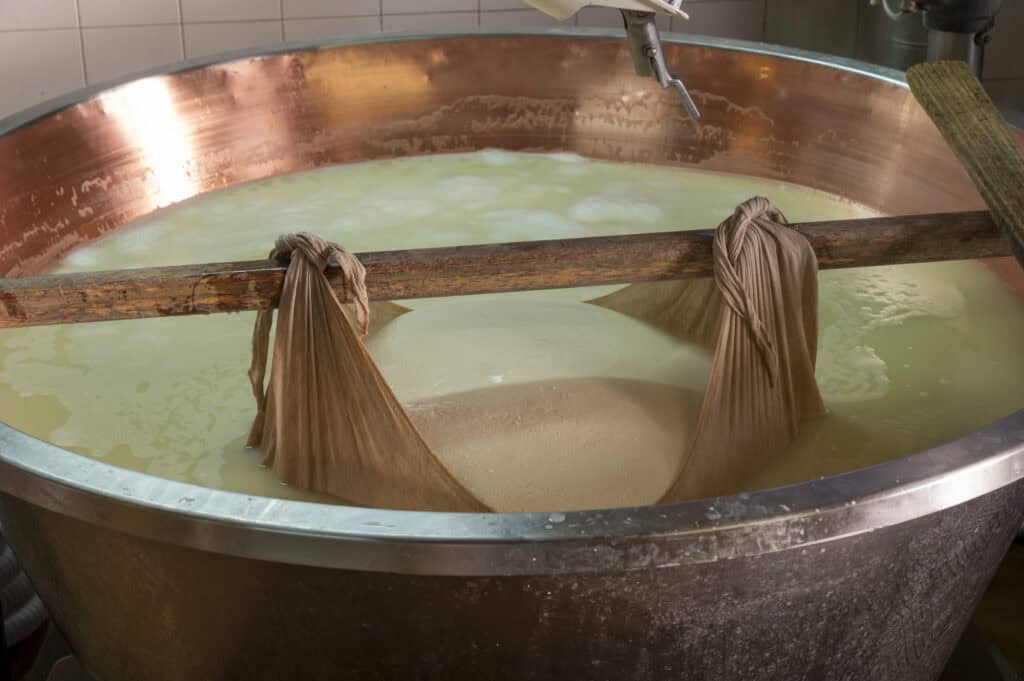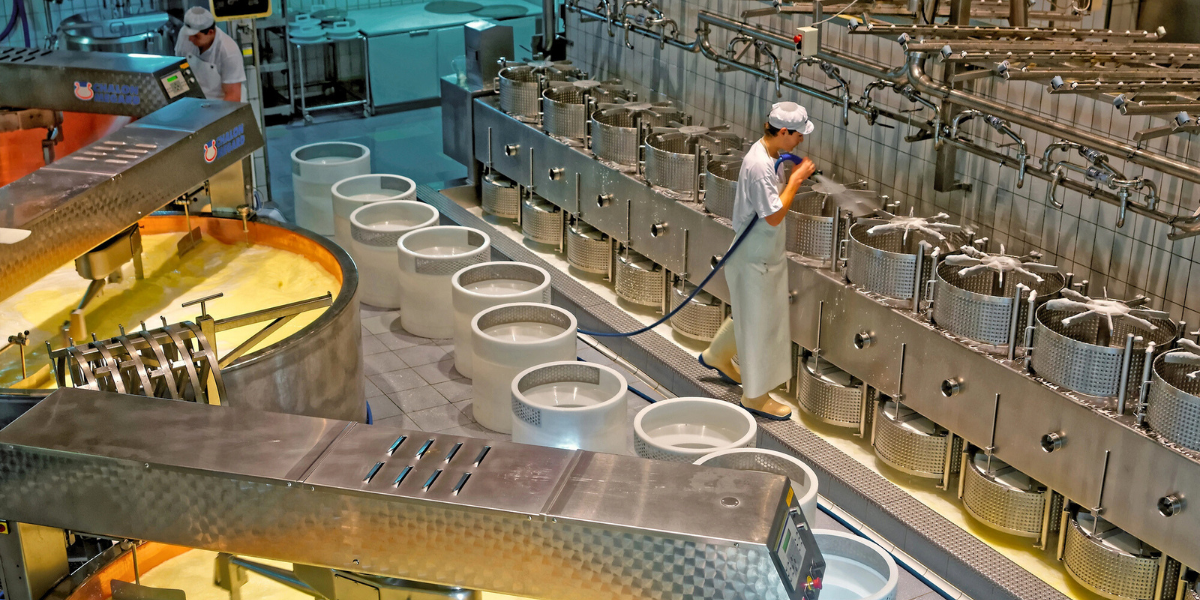By Carter Trent
EDITOR’S SUMMARY: FPC rennet, a genetically engineered enzyme, is now used in the vast majority of cheeses on the market—yet few people know it’s there. As a product of GMO fermentation, it raises questions about labeling, transparency, and potential health risks that haven’t been fully explored. By looking more closely at how this enzyme is made and used, you get a clearer view of how biotech-driven processes have quietly become part of mass-produced cheese without much public awareness or debate.
Americans adore cheese. Consumption of this flavorful food has been rising for decades, hitting an all-time high in 2023. That year, the amount of cheese eaten annually hit 40.2 pounds per person, more than a 100% increase from 17.5 pounds in 1980. To meet rising demand, manufacturers began moving away from traditional, animal-based rennet in favor of a laboratory-engineered alternative known as fermentation-produced chymosin (FPC) rennet—a synthetic enzyme shortcut with hidden consequences. Rennet is a group of enzymes traditionally used in cheesemaking to coagulate milk, forming the curds that become cheese. While essential for most aged and firm cheeses, some fresh cheeses rely on acid or other coagulants instead of rennet to create their texture.
FPC rennet was born in a laboratory, and created from genetically-modified organisms (GMOs). Today, 90% of cheese in the United States is made with the substance. Moreover, no regulations require its identification on packaging, hindering your ability to make an informed choice. The problem with this product is that its safety was based on a 90-day toxicity study in rats. No long-term research into the potential risks of FPC rennet has been conducted. So how did a little-tested GMO enzyme come to dominate the cheese industry? It begins with recognizing rennet’s vital function in creating cheese.

A primer to rennet’s role in cheesemaking
Milk is the main ingredient in dairy cheese. When an enzyme like chymosin—found in rennet—is added, the milk begins to congeal. As a biological catalyst, chymosin speeds up the reaction by binding to milk proteins, causing them to form solid masses. This coagulation separates the clumps from the liquid whey. The whey is drained off, leaving curds that form the basis of cheese. The adoption of FPC rennet is a relatively recent development in the long history of cheesemaking. For thousands of years, natural rennet was sourced from the stomachs of infant ruminant animals—such as calves, kids, or lambs. These young herbivores produce enzymes in their digestive systems to break down their mother’s milk, making them an ideal natural source for cheese production.
While animal rennet has been the traditional source of milk-clotting enzymes, it’s not the only option. Plant-based alternatives—derived from ingredients like fig sap, artichoke, safflower, and nettle—offer a choice favored by vegans and vegetarians. Although botanical rennet functions similarly to its animal-based counterpart, it comes with some drawbacks. Cheese made with plant enzymes tends to age poorly, resulting in a shorter shelf life, and can vary in firmness, texture, and flavor due to inconsistent enzyme composition.
Microbial rennet is another option, produced through fermentation using molds, fungi, or yeast—most commonly the fungal species Rhizomucor miehei. These microbes convert sugars into enzymes that coagulate milk. While the microorganisms themselves are not typically genetically modified, they are most often grown on a nutrient base derived from GMO soy. Non-GMO microbial rennet—produced using certified non-GMO feedstocks and manufacturing practices—may be approved for use in organic cheese, provided it meets USDA National Organic Program standards. When carefully controlled by skilled cheesemakers, microbial rennet can produce consistent results. However, if not managed properly, it can lead to inconsistent taste, texture, and production yields, because the enzymes break down milk proteins more extensively. For these reasons, animal-derived rennet remained the primary option for cheese producers until the mid-20th century.
Unpacking the Dominance of FPC Rennet in Cheese
The sourcing of rennet began to shift in the 1960s as the animal rights movement raised ethical concerns about using baby herbivores—understandably so, since these infants were often only days old when slaughtered for their stomachs. As consumer sentiment moved away from traditional rennet extracted from animals, demand for cheese was simultaneously rising. Packaged and frozen foods containing cheese—like frozen pizzas and pre-packaged slices—became increasingly popular. At the same time, fast food chains expanded their menus to include cheese-laden items such as tacos, cheeseburgers, and sandwiches.
Manufacturers needed a cheap, efficient way to produce cheese on a massive scale to keep up with exploding demand. That’s when science stepped in—with the arrival of recombinant DNA (rDNA) technology. This technique involves manipulating DNA from microorganisms to create genes with traits not found in nature, often to improve efficiency or consistency in food production. For instance, rDNA has been used to extend the shelf life of the Flavr Savr tomato and prevent browning in the Arctic apple. In cheesemaking, it allowed scientists to extract the chymosin gene from calf stomachs and insert it into microbes—creating fermentation-produced chymosin, or FPC rennet.
rDNA technology itself originated in the early 1970s. As a new science at the time, it had no established track record of safety. Its path toward widespread adoption received a significant boost in 1980, when the U.S. Supreme Court ruled in the landmark case “Diamond v. Chakrabarty.” This decision allowed businesses to patent genetically engineered life forms, paving the way for commercial development of genetically modified products.
This turning point for rDNA technology was followed by another milestone a decade later. In 1990, the U.S. Food and Drug Administration (FDA) approved the use of FPC rennet in food. The pharmaceutical giant Pfizer is credited with creating this GMO product, using gene splicing technology—an early genetic engineering technique that preceded more advanced methods available today, such as clustered regularly interspaced short palindromic repeats (CRISPR). The FDA’s approval was particularly significant as it marked the first time a genetically engineered product was authorized for consumption. Although rDNA technology was still emerging and lacked a long-term safety record in food, the agency granted FPC rennet the designation of “generally recognized as safe” (GRAS). Achieving GRAS status allowed Pfizer to bypass the formal approval process typically required for new food additives. This procedure was designed to protect consumers by requiring the FDA to conduct a safety review and provide an opportunity for public comment on new products. Instead, Pfizer’s laboratory-produced food ingredient entered cheese without an FDA safety assessment, based on the determination that bioengineered chymosin rennet was chemically equivalent to calf rennet.
Once the U.S. government gave its consent, FPC rennet quickly gained widespread adoption in the cheese industry thanks to its advantages. Precisely controlled through genetic modification, it yields cheese with uniform texture and quality. This boosts manufacturing efficiency and reduces costs, since naturally produced rennet can introduce variability that sometimes leads to discarded batches. Because FPC rennet is derived from calf genes, its taste closely resembles that of the animal-based equivalent. While no research specifically indicates dangers from FPC rennet, studies do highlight potential risks associated with GMO-produced foods in general. For example, the Institute for Responsible Technology noted in “Genetically Engineered Foods May Cause Rising Food Allergies (Part One)”:
“These unlabeled genetically modified foods carry a risk of triggering life-threatening allergic reactions, and evidence collected over the past decade now suggests that they are contributing to higher allergy rates.”
In 2019, the scientific journal Current Opinion in Food Science published a review of genetically modified enzymes, including chymosin, confirming the possibility that GMOs may trigger new food allergies. The research stated, “Genetic modification of enzymes may also change their allergenic properties, posing new potential health risks.” Another concern is their likely impact on your gut microbiome. A 2023 research paper titled “The Influence of GMOs on the Composition of the Gut Microbiome,” which examined how GMO-based foods affect the intestines, explained:
“The human gut microbiome plays an essential role in many physiological mechanisms, including nutrition and immune function, host metabolism, and physiology. Disruption of the gut microbiome can lead to significant health issues such as obesity, malnutrition, systemic diseases like diabetes, and chronic inflammatory diseases.”
The study noted that the scientific community remains divided on foods involving GMOs and that their safety remains controversial, stating:
“The debate regarding if GMOs can interfere with human health, specifically the gut microbiome, is ongoing. Many studies have suggested that consuming GMO products can lead to variations in the gut microbiome composition. Other studies have indicated that the changes in the composition gut microbiome are insignificant, implying that consumption of GMO products have little to no effect. Information has been on both ends of the spectrum, with some studies emphasizing the extent of the harmful effects and others producing inconclusive or conflicting results, lacking substantial answers.”
Raw cheese and rennet: An introduction
Cheese made from unpasteurized milk represents a traditional approach to cheesemaking that preserves the natural enzymes and bacteria influencing flavor and texture. Historically, raw cheeses relied on animal or microbial rennet rather than the genetically engineered FPC commonly used today. While artisanal raw cheeses often stick to these traditional rennet sources, the use of FPC rennet is gradually making its way into larger-scale production. For raw cheese enthusiasts, the combination of raw milk and traditional rennet is essential for preserving authentic flavors and the unique character of the milk’s origin. Parmigiano Reggiano, for example, is protected under strict regulations that require the use of raw milk and animal rennet—not microbial rennet or FPC—ensuring its authenticity and traditional quality. Safety concerns surrounding unpasteurized milk have often led to heavy-handed regulations from the commercial dairy industry—measures that critics say aren’t always warranted given traditional practices and modern hygiene standards. Additionally, labeling around rennet in raw cheeses is not always clearly disclosed, leaving you unaware of the invisible ingredients shaping your cheese. Understanding these nuances can help you make more informed choices about the cheese you enjoy. As Miller’s Bio Farm asks in “Is your raw cheese actually raw? Or has it been greenwashed?”:
“The type of enzymes (or rennet) used and the origin of those enzymes (animal, plant, or microbial) do NOT need to be listed. A label can simply say ‘enzymes’ or ‘rennet.’”

Avoiding FPC Rennet: What You Can Do
Since the risks of consuming FPC rennet remain unclear, a sensible approach is to avoid it altogether. However, this isn’t always straightforward. Although a law like the National Bioengineered Food Disclosure Standard, requires bioengineered foods to be identified on packaging, genetically modified cheese does not need to carry such labels. This is because the government considers it equivalent to the traditional animal-derived version. Since most U.S. cheese is made using FPC rennet, here are some steps you can take to steer clear of it. First, choose cheese labeled organic. Certified organic foods legally prohibit genetically modified organisms. Another advantage of organic cheese is that its standards require livestock to have outdoor access, reducing the likelihood that the rennet comes from CAFO cows (Concentrated Animal Feeding Operations), where animals are often given antibiotics and fed GMO corn.
Next, consider cheeses that don’t require rennet. Many soft cheeses are made without it—including paneer, cottage cheese, cream cheese, some mozzarella, and mascarpone. Check product packaging carefully: terms like “rennet free” confirm its absence, while mentions of “enzymes” usually indicate rennet was used. A good strategy is to seek out cheesemakers who craft cheese in ways that align with your values and health goals. Many artisanal producers take pride in using traditional techniques and avoiding FPC rennet. When dining out, it’s best to skip cheese unless you’ve done your research and know the restaurant uses organic or non-GMO ingredients. That means staying away from fast-food chains, many of which rely on FPC rennet and factory-farmed dairy. Their products are often packed with fillers and additives—sometimes to the point that they’re not truly cheese at all.
This cautionary tale about America’s love affair with cheese goes beyond changing production methods. It raises deeper questions about ethics, transparency, and human health. The rise of genetically engineered food shows how the rush to embrace new technology often overlooks its downsides, leaving you reactive rather than informed. It challenges you to consider how convenience and cost-efficiency can mask long-term health consequences. Yet this moment also offers an opportunity to become more intentional about your food choices and the systems you support. In a world increasingly shaped by biotechnology, perhaps the most powerful ingredient on your plate is still awareness.
~
Published on July 31, 2025.
If you’ve found value in this article, please share it!
To support the research and health education of AVFC editorial, please consider making a donation today. Thank you.

